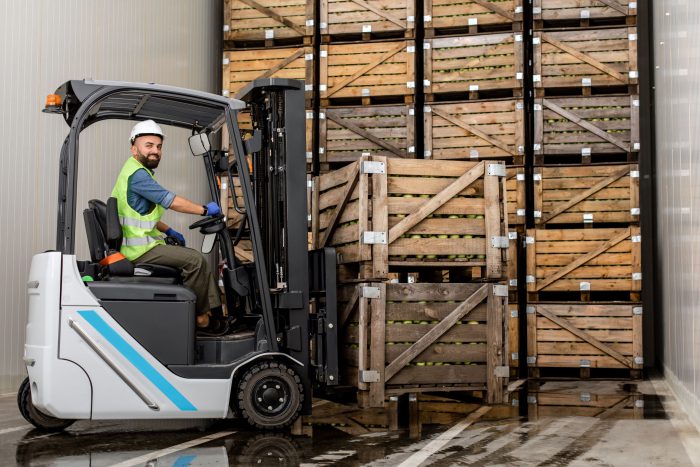Gian-Gabriel Masoni Dobles, Contributing Writer, Zondits 5/2/2023
Wes Whited, Zondits contributor
Throughout industry, forklifts are everywhere. Statistical research firms estimate that nearly 1.5 million forklifts are sold every year, worldwide. And forklifts represent a huge opportunity in the transition to clean energy.
How so? Forklifts are powered by either fossil fuel (gasoline, diesel, propane) engines or electric motors and rechargeable batteries. The same advances driving the EV market are making electric forklifts all the more desirable and practical.
Homeowners are increasingly interested in clean energy upgrades and EVs, even though it often means modifying their home’s electric system. Large warehouses and industrial facilities, on the other hand, typically have the necessary electrical infrastructure to readily install charging equipment for industrial material handling trucks. Electrification of material handling, specifically forklifts and their cousins, clamp/roll/pallet/platform trucks, is an easy way to electrify resulting in large impacts not easily achieved one home at a time.
Cutting across nearly every type of warehouse is the ubiquitous lift truck. According to industry sources, 60% of the forklifts now sold are electric. And, while electric forklifts with lead-acid rechargeable batteries have been in use for decades, there are millions of combustion engine (ICE) forklifts in use every day. ICE powered forklifts are also problematic for use inside facilities where indoor air quality is a problem for workers. Propane burns cleaner than other fossil fuels and has been a typical choice, but nothing compares with electric motors. ICE motors burn fossil fuels and only deliver about 20% of their energy into work. By contrast, electric forklifts do not need to convert fuel into electricity, allowing them to deliver 65-70% of their energy into work. Furthermore, ICE forklifts have high carbon intensities. Let’s assume two fork forklifts with identical lift capacities each operating 40 hours per week for one year. In this scenario, the electric truck uses 103 MMBTUs of energy, and the diesel truck consumes 495 MMBTUs of energy, meaning the electric truck uses about 4.5 times less energy to complete the same task. The environmental impact of switching to electric works out to about 54,000 pounds of CO2 saved per year of operations, depending upon the source of electricity being delivered to the charging stations.
The ideal candidate
Apart from anticipated lower total lifetime ownership (LTO) costs for a facility, a pivot to electric forklifts will result in cleaner air, zero tail pipe emissions, and a quieter working environment, all of which enhance worker safety.
Just as new battery chemistries have made road-going EVs more attractive, they have done the same for forklifts. Maintaining conventional lead acid batteries is a significant challenge and drain on resources, as they need to be removed from the forklifts periodically to be watered and charged. Or in some cases, each truck has two dedicated batteries with one connected to the charger while the other is on the truck. In contrast, lithium-ion batteries can be incidentally charged during an hour-long lunch break and then fully charged when the worker is back on the floor. This makes the switch to electric forklifts a practical choice for warehouse owners looking to reduce their long-term ownership costs and contribute to a cleaner environment.
A modern electric fork truck battery is fundamentally like that of any electric vehicle in the way of general chemistry, and can setup a facility to unlock additional benefits of vehicle to grid (V2G) or vehicle to everything (V2X) applications in the future. The electric forklift not only performs its function but dovetails into projections for electrified fleets and future storage capacity of the facility itself.
Market dynamics
Whether companies are taking initiative for the sake of safeguarding their brands, ‘greening’ operations or are largely reactive, organizations are aiming to capitalize on the economic advantages of electrification where possible. The benefits of lower total cost of lifetime ownership, ability to meet corporate defined decarbonization goals, or just a cleaner, healthier, more operationally efficient workspace are undeniable. This is expected to accelerate the technology’s diffusion curve with the help of utility sponsored market transformation programs.
Utilities have a critical role to play in that they’re essentially buying down the incremental cost between the efficient product and their legacy counterparts while de-risking. By buying a lithium battery truck for the same price as you could buy a propane truck, asset managers experience ancillary benefits and modernize in the process.
In researching this article, I asked Wes Whited of DNV about the regulatory challenges for utilities to promote electric forklifts to facility operators. The answer is not ideal. “Electrification from a regulatory perspective is really hard because the government is basically forcing the utilities to pick winners and losers”, said Wes. “We need to get more types of advanced products into our traditional energy efficiency programs, the answer is unlocked by thinking outside of the box and unearthing backdoor ways to practically carry out decarbonization. The forklift is an easy arbitrage opportunity.”
